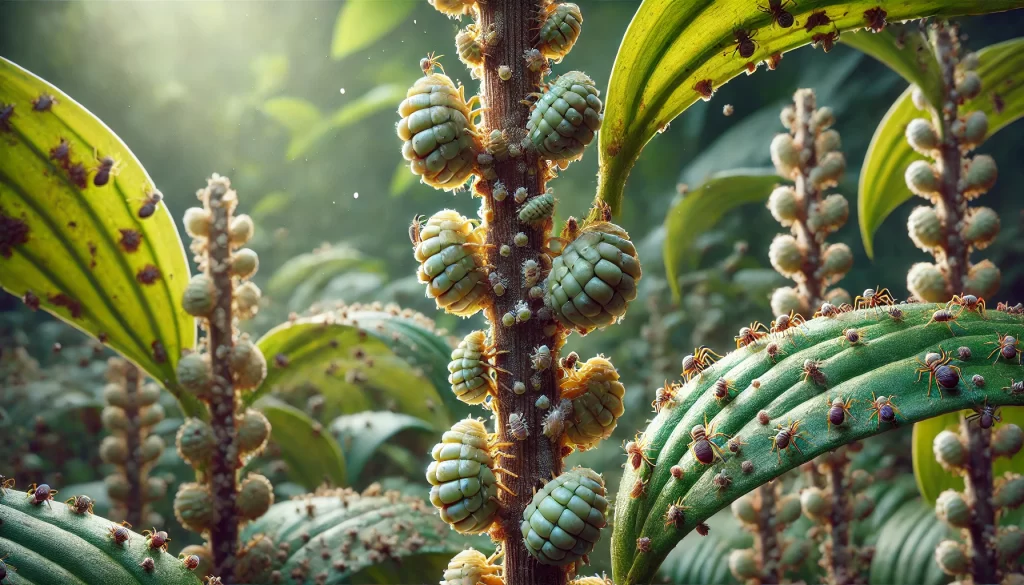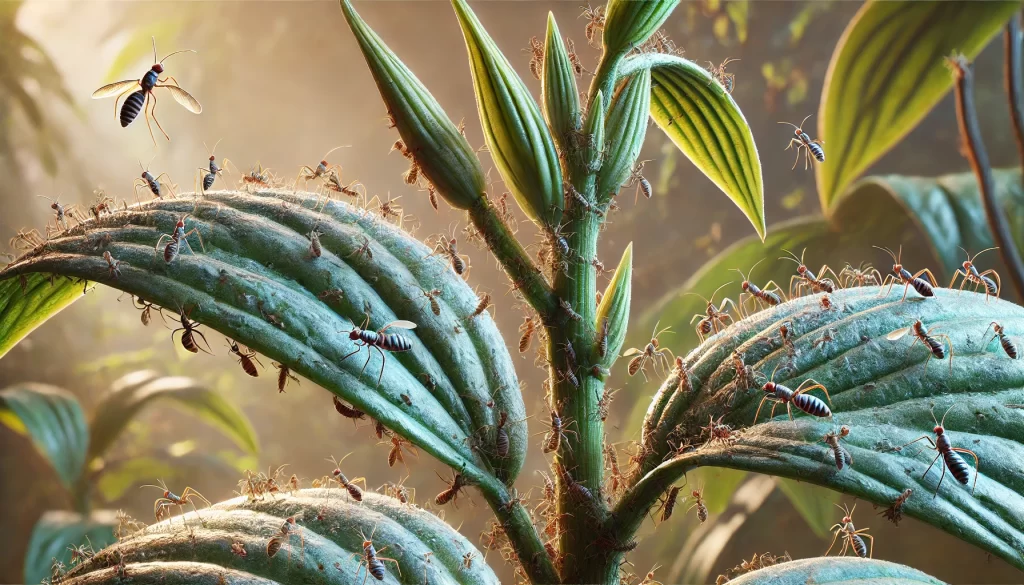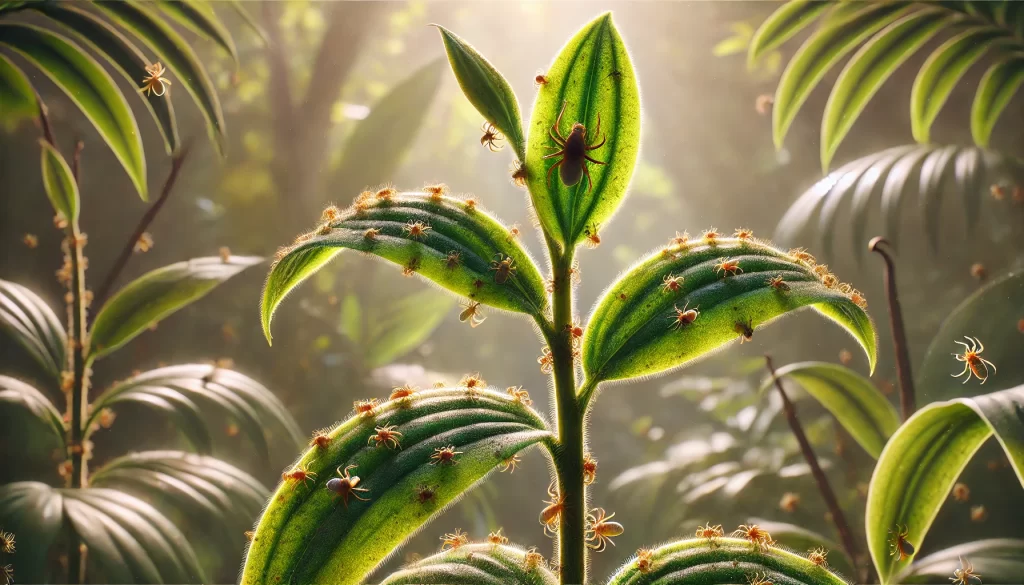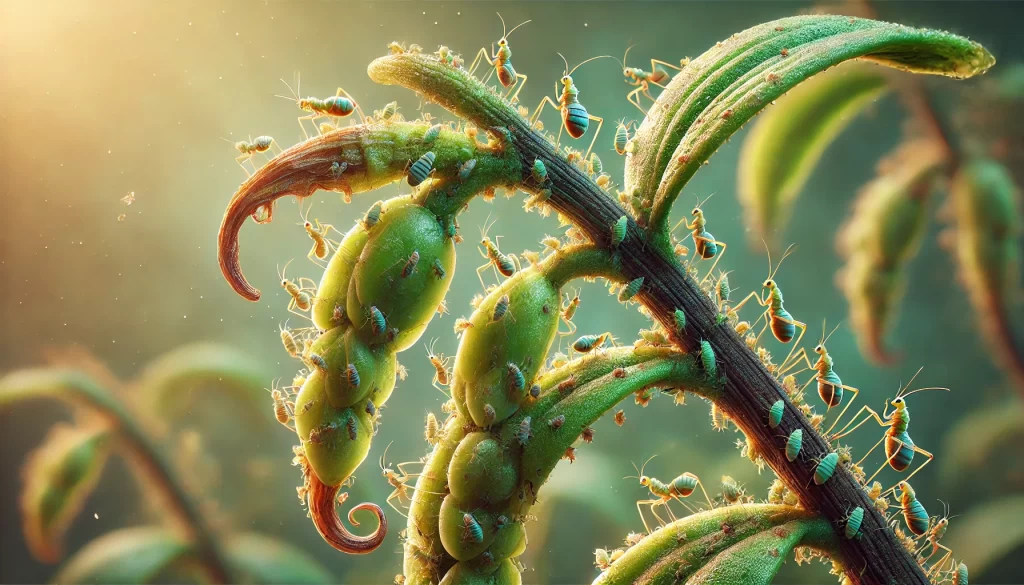Vanilla cultivation, although valuable and rewarding, faces various challenges related to pests that can affect plant health and production quality. Knowing the most common pests and applying appropriate control strategies is essential to maintaining a healthy and productive crop. Below, the main pests affecting vanilla cultivation are detailed, along with practical methods for their management and control.
1. Scale Insects
Description:
Scale insects are small sap-sucking insects that adhere to stems and leaves, excreting a sticky substance called honeydew, which favors the appearance of fungi and attracts other insects.
Control Methods:
- Manual control: Regularly inspect the plant and manually remove the scales with a soft brush or damp cloth.
- Horticultural oils: Apply oil-based solutions that suffocate these insects without harming the plant.
- Biological control: Encourage the presence of natural predators such as ladybugs, which feed on scales.
- Organic pesticides: Use specific products based on insecticidal soap in case of severe infestations, always following the manufacturer’s recommendations.

2. Thrips
Description:
Thrips are small, winged insects that feed on sap, causing deformations in leaves and pods. They also cause the appearance of silvery spots and stress the plant.
Control Methods:
- Adhesive traps: Place blue or yellow traps to monitor and reduce thrip populations.
- Selective insecticides: Apply products that control thrips without affecting beneficial insects.
- Biological control: Introduce predatory mites or beneficial insects that feed on thrips.
- Cultural management: Keep the area around the crop clean to reduce shelter for these pests and improve air circulation.

3. Mites
Description:
Mites, especially spider mites, can infest the underside of leaves, causing discoloration, premature drop, and weakening of the plant.
Control Methods:
- Horticultural oils and potassium soap: Apply these products to get rid of mites in larval and adult stages.
- Mite-specific insecticides: Use acaricides as directed to control severe outbreaks.
- Promotion of natural enemies: Encourage the presence of predatory mites and other beneficial insects.

4. Aphids
Description:
Aphids are small sap-sucking insects that feed on sap, producing honeydew that favors secondary diseases like mold.
Control Methods:
- Biological control: Introduce ladybugs, lacewings, or other natural aphid predators.
- Insecticidal soap: Apply soapy solutions to get rid of aphids without harming the plant.
- Inspection and manual removal: In minor infestations, manually remove aphids with water or a damp cloth.

5. Fungi and Other Pest-Related Diseases
Description:
The excretions of some insects, such as scale insects and aphids, can favor the development of fungi and molds that attack leaves, stems, and pods.
Control Methods:
- Moisture control: Avoid excess moisture on foliage and soil, as this facilitates the appearance of fungi.
- Organic fungicides: Apply copper- or sulfur-based products to prevent and control fungal diseases.
- Removal of infected material: Remove affected leaves and pods to prevent the spread of fungus.
General Integrated Pest Management (IPM) Strategies
- Constant monitoring: Regularly inspect the crop to detect pests in time and apply targeted treatments.
- Crop rotation and environment management: Diversify crops and keep areas clean to decrease pest incidence.
- Promotion of biodiversity: Grow companion plants and maintain habitats for natural enemies, reducing the need for chemical products.
- Responsible use of chemicals: When necessary, use selective pesticides and always follow instructions to minimize harm to the environment and beneficial insects.
Conclusion
Effective pest management in vanilla cultivation requires an integrated approach that combines cultural practices, biological control, and prudent use of chemicals when indispensable. By implementing these strategies, producers can keep their crops healthy, minimize losses, and ensure high-quality vanilla production. The key is constant vigilance and adapting methods according to the specific conditions of the crop and region.
 AgronoBlog – Agriculture Blog
AgronoBlog – Agriculture Blog 


